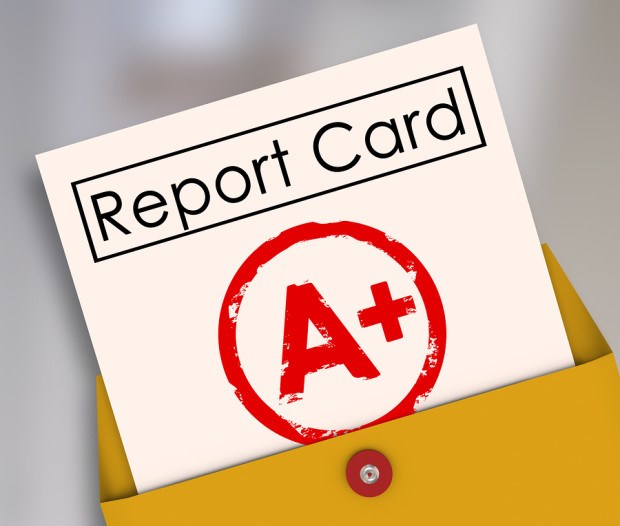Vermont, Utah, Iowa, Virginia and Kentucky get an “A” and North Carolina an “F” in one think tank’s annual grading of how states regulate the property/casualty insurance industry.
The 2015 Insurance Regulation Report Card, the R Street Institute’s annual publication, assigned scores in 10 different areas including solvency monitoring, anti-fraud efforts, rating and underwriting freedom, minimizing politicization of regulation, consumer protection, and fostering competitive markets.
 For 2015, all but nine states received a passing grade of “C” or better in the report. In last year’s report, 11 states failed to get a passing grade.
For 2015, all but nine states received a passing grade of “C” or better in the report. In last year’s report, 11 states failed to get a passing grade.
“On balance, we believe states have done an effective job of encouraging competition and, at least since the broad adoption of risk-based capital requirements, of ensuring solvency,” the report says.
However, the report takes issue with state regulations that it says lead to inefficiencies, as well as state laws and regulations that “have the effect of discouraging capital formation, stifling competition and concentrating risk.”
“Reviewing the data on insurance in 2015, we see mostly stable trends in consumer and business freedom in state insurance markets,” said R Street Editor-In-Chief and Senior Fellow R.J. Lehmann, the author of the study. “In some states, notably Florida, real efforts were made to scale back, or otherwise place on more sound financial footing, residual insurance markets and state-run insurance entities. Other states, notably North Carolina, appear to be moving in the wrong direction.”
R Street said North Carolina received a failing grade in part due to the state’s rate bureau system and growth of the residual market FAIR Plan and Beach Plan.
Louisiana, New York, Texas, Florida, California, Hawaii and Montana also came in at the bottom with low grades of “D.”
Vermont did well enough in almost all areas including consumer protection, politicization, auto and homeowners insurance environments, rate freedom and clarity, and regulatory restrictions to earn the best grade in the country.
Other states receiving “A” grades in this 2015 report were Utah, Iowa, Virginia and Kentucky.
In 2014’s report card, eight states—Vermont, Virginia, Illinois, Iowa, Maine, Utah, Ohio and Kentucky—received “A” grades. But this year Illinois, Ohio and Maine fell to a “B.”
R Street bills itself as a think tank dedicated to free markets. R Street believes that “an open and free insurance market maximizes the effectiveness of competition and best serves consumers.” It grades states’ regulatory systems against principles of “limited, effective and efficient” government.
“In this context, that means states should regulate only those market activities where government is best-positioned to act; that they should do so competently and with measurable results; and that their activities should lay the minimum possible financial burden on policyholders, companies and, ultimately, taxpayers,” according to R Street.
R Street says it attempts to answer three questions with its analysis:
- How free are consumers to choose the insurance products they want?
- How free are insurers to provide the insurance products consumers want?
- How effectively are states discharging their duties to monitor insurer solvency, police fraud and consumer abuse and to foster competitive, private insurance markets?
In the analysis, the 11 states with elected insurance commissioners automatically lose points.
Also, two states where legislators passed market-restricting laws lost points: Hawaii for its measure ending the moratorium on policies in lava-flow areas and Texas for the way it restructured the Texas Windstorm Insurance Association.
The report also looks at regulatory decisions that restrict markets. It penalizes nine states (California, Delaware, Florida, Indiana, Maine, Ohio, Pennsylvania, Rhode Island and Washington) that issued regulatory bulletins barring the use of price optimization. New Mexico, New York and Vermont, which issued advisories seeking more information on price optimization practices, were not penalized.
Oklahoma lost points for its bulletin “pressuring insurers not to deny fracking-related earthquake claims” and Florida for denying Florida Hurricane Catastrophe Fund officials the flexibility to bind reinsurance coverage without the cabinet’s prior approval.
Costs to Industry
The report also notes that states continue to draw far more in regulatory fees and assessments from the insurance industry than they spend on insurance regulation. According to the report, the 50 states, Puerto Rico and the District of Columbia spent $1.33 billion on insurance regulation in 2014 but collected close to $3 billion in regulatory fees and assessments from the insurance industry.
“These surplus regulatory fees and assessments end up in state coffers to patch other holes in state budgets,” Lehmann said. “They serve as a hidden tax on insurance consumers, raising the cost of coverage for everyone.”
If premium taxes, fines and other revenues are included in the tally, only 6 percent of the $21.9 billion states collected from the insurance industry last year was spent on insurance regulation, down from 6.4 percent the prior year and 6.6 percent in 2012, according to the report.
Summary of Grades
The states receiving “A” grades are: Vermont (A+), Utah, Iowa, Virginia and Kentucky, while Nebraska, Tennessee and South Carolina got an “A-.”
North Carolina received an “F,” while Louisiana, New York, Texas, Florida, California, Hawaii and Montana got a “D.”
Eighteen states received “B+,” “B” or “B-” scores: Wyoming, South Dakota, Nevada, Oregon, Arizona, Colorado, Missouri, Wisconsin, Idaho, New Hampshire, Illinois, Maryland, Maine, New Jersey, Ohio, New Mexico, Arkansas and Connecticut.
Fifteen are graded “C+,” “C” or” C-“: Indiana, Minnesota, Kansas, Rhode Island, Alabama, Alaska, North Dakota, Delaware, West Virginia, Pennsylvania, Michigan, Oklahoma, Washington, Georgia and Massachusetts.





















 The Future of Knowledge in Insurance: From Training to AI-Powered Productivity
The Future of Knowledge in Insurance: From Training to AI-Powered Productivity  Odometer Fraud Sees 14% Jump in the Past Year
Odometer Fraud Sees 14% Jump in the Past Year  Chubb, The Hartford, Liberty and Travelers Team Up on Surety Tech Co. Launch
Chubb, The Hartford, Liberty and Travelers Team Up on Surety Tech Co. Launch  Examining 5 Key Factors Fueling MGA Growth—and Emerging Challenges Ahead
Examining 5 Key Factors Fueling MGA Growth—and Emerging Challenges Ahead 








